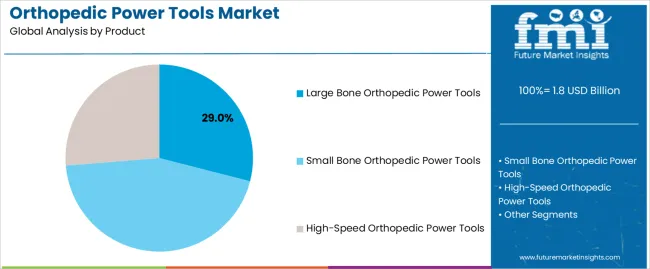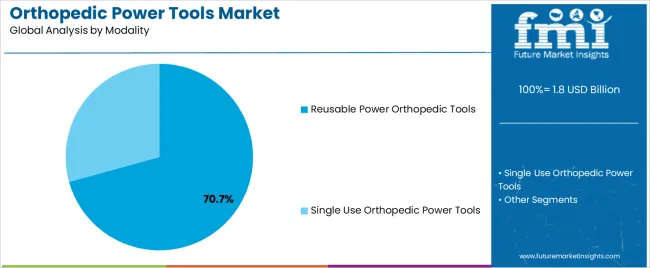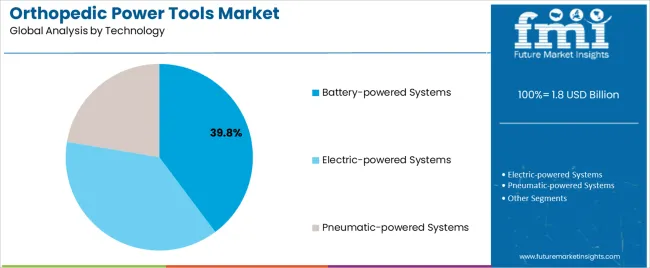The orthopedic power tools market is exhibiting steady expansion, driven by the increasing volume of orthopedic procedures and the evolution of surgical techniques that demand precision, efficiency, and control. Industry announcements and surgical equipment manufacturers' reports have indicated that orthopedic centers and hospitals are increasingly investing in high-performance power tools to enhance surgical outcomes and reduce operating time.
Rising geriatric populations and a growing prevalence of musculoskeletal conditions, including fractures, arthritis, and sports injuries, have contributed to the steady rise in orthopedic surgeries globally. Additionally, technological advancements in motor efficiency, ergonomic tool design, and modular configurations are supporting the shift toward next-generation tools that improve procedural accuracy.
Healthcare providers are also favoring tools that support streamlined sterilization workflows and reduce cross-contamination risks, especially in high-volume surgical environments. Moving forward, the market is expected to benefit from innovations in battery technology, smart surgical platforms, and growing investments in ambulatory surgical centers. Segmental growth is being led by Large Bone Orthopedic Power Tools in product usage, Reusable Power Orthopedic Tools in modality preference, and Battery-powered Systems in technology adoption.

| Metric | Value |
|---|---|
| Orthopedic Power Tools Market Estimated Value in (2025 E) | USD 1.8 billion |
| Orthopedic Power Tools Market Forecast Value in (2035 F) | USD 2.6 billion |
| Forecast CAGR (2025 to 2035) | 4.2% |
The market is segmented by Product, Modality, Technology, and End User and region. By Product, the market is divided into Large Bone Orthopedic Power Tools, Small Bone Orthopedic Power Tools, and High-Speed Orthopedic Power Tools. In terms of Modality, the market is classified into Reusable Power Orthopedic Tools and Single Use Orthopedic Power Tools. Based on Technology, the market is segmented into Battery-powered Systems, Electric-powered Systems, and Pneumatic-powered Systems. By End User, the market is divided into Hospitals, Ambulatory Surgical Centers, and Orthopedic Clinics. Regionally, the market is classified into North America, Latin America, Western Europe, Eastern Europe, Balkan & Baltic Countries, Russia & Belarus, Central Asia, East Asia, South Asia & Pacific, and the Middle East & Africa.

The Large Bone Orthopedic Power Tools segment is projected to contribute 29.0% of the orthopedic power tools market revenue in 2025, maintaining its lead among product categories. This dominance has been shaped by the high demand for tools capable of handling complex and high-force orthopedic procedures such as joint replacement, femoral and tibial osteotomies, and trauma fixation.
Clinical usage data and surgical practice updates have shown that large bone procedures typically require powerful, torque-driven tools capable of cutting through dense skeletal structures with precision. Surgeons have favored this segment for its durability, adaptability to interchangeable attachments, and compatibility with advanced orthopedic implants.
Furthermore, as total hip and knee arthroplasties continue to rise in both hospital and outpatient settings, the need for reliable large bone tools has remained strong. Investment in this segment by manufacturers has led to continuous improvements in device weight, power-to-size ratio, and surgeon ergonomics, ensuring its continued relevance across a range of orthopedic subspecialties.

The Reusable Power Orthopedic Tools segment is expected to hold 70.7% of the orthopedic power tools market revenue in 2025, securing its position as the leading modality. Growth in this segment has been attributed to cost-efficiency over the long term, as reusable tools are engineered for extended use through multiple surgical cycles.
Hospitals and surgical centers have prioritized reusable tools to reduce per-case expenditure while maintaining consistency in performance. Manufacturer disclosures and surgical equipment tenders have confirmed that these tools are often preferred for their durability, adaptability across various procedures, and established sterilization protocols.
Additionally, the growing focus on environmental sustainability in healthcare has encouraged providers to reduce medical waste, thereby further supporting the adoption of reusable tools. Although initial capital investment is higher, the ability to amortize costs over time and the availability of service contracts for maintenance and repair have solidified the segment’s leading role in operating room procurement strategies.

The Battery-powered Systems segment is anticipated to capture 39.8% of the orthopedic power tools market revenue in 2025, emerging as the dominant technology type. This growth has been driven by the increasing clinical preference for mobility, reduced setup complexity, and operational flexibility in surgical environments.
Technological advancements have enabled battery-powered systems to match the torque and performance standards of traditional pneumatic tools while offering greater freedom of movement and reduced dependence on external power sources. Surgeon feedback and operating room optimization studies have emphasized the value of cordless tools in improving workflow efficiency and minimizing the risk of cable-related contamination.
Furthermore, ongoing innovation in lithium-ion battery technology has improved charge retention, reduced charging time, and extended device runtime, addressing previous limitations of battery-powered devices. As healthcare systems aim to enhance surgical productivity and reduce turnaround times, the Battery-powered Systems segment is expected to maintain its upward trajectory, especially in high-volume orthopedic centers and ambulatory surgical units.
The rising prevalence of orthopedic disorders such as osteoarthritis, osteoporosis, and fractures due to accidents or sports injuries has contributed to the demand for orthopedic power tools. There has been a steady increase in the number of orthopedic surgeries performed worldwide, including joint replacement surgeries, spine surgeries, and trauma surgeries. This surge in surgical procedures necessitates the use of advanced tools and equipment, including orthopedic power tools, thereby fueling industry growth.
Stringent regulations governing the manufacturing and sale of medical devices have ensured product quality, safety, and efficacy. Regulatory bodies play a crucial role in assessing and approving orthopedic power tools, instilling confidence among healthcare professionals and patients and fostering industry growth. The integration of robotics and automation into orthopedic surgery is a significant trend.
Robotic-assisted orthopedic surgery offers increased precision, accuracy, and consistency in procedures such as joint replacements and spinal surgeries. These systems work in conjunction with orthopedic power tools to enhance surgical outcomes.
The adoption of 3D printing technology in orthopedic surgery is revolutionizing the design and manufacturing of implants, instruments, and surgical guides. Orthopedic power tools are increasingly being utilized in conjunction with 3D-printed components to achieve optimal surgical outcomes. This trend allows for rapid prototyping, customization, and complex geometries that were previously unattainable with traditional manufacturing methods.
Wireless orthopedic power tools equipped with Bluetooth or Wi-Fi connectivity are gaining traction. These tools enable seamless communication with other surgical devices, imaging systems, and electronic health records, streamlining workflow efficiency and enhancing surgical collaboration. Wireless power tools offer greater mobility and maneuverability in the operating room.
There is a growing demand for portable and handheld orthopedic power tools that offer flexibility and ease of use in various surgical settings, including operating rooms, ambulatory surgical centers, and clinics. Manufacturers are focusing on developing lightweight and ergonomic tools that optimize surgeon comfort and dexterity during procedures.
With growing environmental concerns, there is a shift towards sustainable and eco-friendly solutions in the healthcare industry, including orthopedic power tools. Manufacturers are exploring recyclable materials, energy-efficient manufacturing processes, and eco-conscious packaging to reduce the environmental footprint of their products. This trend aligns with the broader sustainability initiatives within the healthcare sector.
The United States boasts a robust market for orthopedic power tools primarily due to its advanced healthcare infrastructure and a high prevalence of orthopedic conditions. The demand is further fueled by the country's large aging population, which necessitates an increasing number of orthopedic surgeries such as joint replacements and spinal procedures.
The United States is characterized by a strong emphasis on technological innovation, leading to the adoption of cutting-edge tools like robotic-assisted surgical systems. These factors contribute to a highly competitive market landscape, with leading orthopedic surgical device manufacturers vying to cater to the evolving needs of healthcare providers and patients.
In the United Kingdom, the demand for orthopedic power tools is driven by the rising prevalence of musculoskeletal disorders and a focus on cost analysis of orthopedic surgical tools in healthcare solutions to drive the market. The country's healthcare system emphasizes efficiency and value for money, influencing the adoption of orthopedic power tools that offer superior performance while contributing to streamlined surgical procedures.
Collaborations between academic institutions and industry players also play a significant role in driving innovation in surgical power tools for orthopedics in the United Kingdom. Moreover, regulatory frameworks promoting patient safety and product quality shape the dynamics of the orthopedic power tools market in the United Kingdom.
In China orthopedic power tools is experiencing rapid growth fueled by demographic shifts, expanding healthcare infrastructure, and increasing healthcare expenditure. The country's aging population and changing lifestyle patterns contribute to a rising incidence of orthopedic conditions, driving the demand for surgical interventions and advanced power tools.
Government initiatives to improve healthcare access and quality further catalyze market growth, as does the growing disposable income and willingness to invest in high-quality healthcare services. Partnerships between domestic and international players facilitate technology transfer and innovation in the Chinese orthopedic power tools market, leading to a dynamic and competitive landscape.
Small bone orthopedic power tools are playing a crucial role in the growth of the orthopedic power tools. These specialized tools are designed for precision and efficiency in surgeries involving smaller bones, such as those in the hands, feet, and facial regions. The growing prevalence of conditions like carpal tunnel syndrome, fractures, and arthritis has increased the demand for surgeries that require these precise tools. The use of small bone power tools allows surgeons to perform delicate procedures with greater accuracy, improving patient outcomes and reducing recovery times.
Technological advancements have led to the development of more ergonomic and user-friendly bone surgery tools. These innovations include improved battery life, lightweight designs, and enhanced maneuverability, which make them more appealing to surgeons. The ability to perform minimally invasive procedures with these tools is another significant factor driving their adoption. Minimally invasive techniques result in smaller incisions, less tissue damage, and faster patient recovery, making them increasingly popular in orthopedic surgeries.
The rise in sports injuries and age-related bone conditions is also contributing to the growth of the small bone orthopedic power tools. As the population ages, the need for orthopedic surgeries, particularly those involving small bones, continues to increase. The growing trend of outpatient and ambulatory surgical centers favors the use of compact and efficient tools that can be easily transported and used in various settings.
Electric-powered systems are significantly enhancing the growth of the orthopedic power tools market. These systems offer several advantages over traditional pneumatic tools, making them increasingly popular among orthopedic surgeons. One key benefit is the consistent and reliable power output, which ensures more precise and efficient surgical procedures.
This precision is critical in orthopedic surgeries, where accuracy can significantly impact patient outcomes. Electric-powered tools are also typically lighter and more ergonomic, reducing surgeon fatigue during lengthy operations and improving overall efficiency.
The reduced noise and vibration levels of electric tools enhance the surgical environment, allowing for better focus and less distraction. This improvement in the working conditions can lead to better surgical results and increased adoption of these tools. Electric-powered systems often come with advanced features such as variable speed controls and integrated safety mechanisms, providing surgeons with greater control and reducing the risk of complications.
The advancements in battery technology have also contributed to the growth of electric-powered orthopedic tools. Modern batteries provide longer operational times and quicker recharging capabilities, ensuring that tools are always ready for use. These technological improvements make electric-powered systems more reliable and practical for busy surgical environments. The overall trend towards automation and precision in surgery aligns well with the benefits offered by electric-powered systems, ensuring their continued growth in the orthopedic power tools industry.

Leading companies in orthopedic power tools market collaborate between research institutions, and healthcare providers has led to the development of innovative orthopedic power tools tailored to meet the specific needs of surgeons and patients. These collaborations facilitate the exchange of knowledge, expertise, and resources, driving market growth through the introduction of cutting-edge technologies.
Key Market Developments
In terms of product, the market encompasses small bone orthopedic power tools, large bone orthopedic power tools, and high-speed orthopedic power tools.
Modality types used in orthopedic power tools are categorized into single use orthopedic power tools and reusable power orthopedic tools.
Based on technology the market is segmented into pneumatic-powered systems, electric-powered systems and battery-powered systems.
In terms of end user, the market is segmented into hospitals, ambulatory surgical centre and orthopedic clinics
In terms of region, the industry is divided into North America, Latin America, Western Europe, South Asia, East Asia, Eastern Europe and Middle East and Africa.
The global orthopedic power tools market is estimated to be valued at USD 1.8 billion in 2025.
The market size for the orthopedic power tools market is projected to reach USD 2.6 billion by 2035.
The orthopedic power tools market is expected to grow at a 4.2% CAGR between 2025 and 2035.
The key product types in orthopedic power tools market are large bone orthopedic power tools, small bone orthopedic power tools and high-speed orthopedic power tools.
In terms of modality, reusable power orthopedic tools segment to command 70.7% share in the orthopedic power tools market in 2025.






Full Research Suite comprises of:
Market outlook & trends analysis
Interviews & case studies
Strategic recommendations
Vendor profiles & capabilities analysis
5-year forecasts
8 regions and 60+ country-level data splits
Market segment data splits
12 months of continuous data updates
DELIVERED AS:
PDF EXCEL ONLINE
Orthopedic Braces and Support Market Forecast and Outlook 2025 to 2035
Orthopedic Contract Manufacturing Market Size and Share Forecast Outlook 2025 to 2035
Orthopedic Digit Implants Market Size and Share Forecast Outlook 2025 to 2035
Orthopedic Prosthetic Device Market Analysis - Size, Share, and Forecast Outlook 2025 to 2035
Orthopedic Splints Market Size and Share Forecast Outlook 2025 to 2035
Orthopedic Software Market Size and Share Forecast Outlook 2025 to 2035
Orthopedic Navigation Systems Market Analysis – Trends, Growth & Forecast 2025 to 2035
Orthopedic Trauma Device Market Trends - Size, Share & Forecast 2025 to 2035
Orthopedic Insole Market Analysis – Size & Industry Trends 2025–2035
Orthopedic Shoes Market Growth – Trends & Forecast 2025 to 2035
Orthopedic Oncology Market Growth - Trends & Forecast 2025 to 2035
A Global Brand Share Analysis for Orthopedic Insole Market
Orthopedic Consumables Market Trends – Industry Growth & Forecast 2024 to 2034
Orthopedic Prosthetics Market Analysis - Size, Share, and Forecast 2024 to 2034
3D Orthopedic Scanning Systems Market
Smart Orthopedic Implants Market
Canine Orthopedic Implants Market Size and Share Forecast Outlook 2025 to 2035
Veterinary Orthopedic Drills Market Size and Share Forecast Outlook 2025 to 2035
Veterinary Orthopedic Market Overview – Trends, Applications & Forecast 2024-2034
Veterinary Orthopedic Injectable Drug Market

Thank you!
You will receive an email from our Business Development Manager. Please be sure to check your SPAM/JUNK folder too.
Chat With
MaRIA